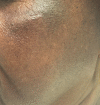Skin Bleaching and Dermatologic Health of African and Afro-Caribbean Populations in the US: New Directions for Methodologically Rigorous, Multidisciplinary, and Culturally Sensitive Research
- PMID: 27837412
- PMCID: PMC5120641
- DOI: 10.1007/s13555-016-0154-1
Skin Bleaching and Dermatologic Health of African and Afro-Caribbean Populations in the US: New Directions for Methodologically Rigorous, Multidisciplinary, and Culturally Sensitive Research
Abstract
Skin-bleaching practices, such as using skin creams and soaps to achieve a lighter skin tone, are common throughout the world and are triggered by cosmetic reasons that oftentimes have deep historical, economic, sociocultural, and psychosocial roots. Exposure to chemicals in the bleaching products, notably, mercury (Hg), hydroquinone, and steroids, has been associated with a variety of adverse health effects, such as Hg poisoning and exogenous ochronosis. In New York City (NYC), skin care product use has been identified as an important route of Hg exposure, especially among Caribbean-born blacks and Dominicans. However, surprisingly sparse information is available on the epidemiology of the health impacts of skin-bleaching practices among these populations. We highlight the dearth of large-scale, comprehensive, community-based, clinical, and translational research in this area, especially the limited skin-bleaching-related research among non-White populations in the US. We offer five new research directions, including investigating the known and under-studied health consequences among populations for which the skin bleach practice is newly emerging at an alarming rate using innovative laboratory and statistical methods. We call for conducting methodologically rigorous, multidisciplinary, and culturally sensitive research in order to provide insights into the root and the epidemiological status of the practice and provide evidence of exposure-outcome associations, with an ultimate goal of developing potential intervention strategies to reduce the health burdens of skin-bleaching practice.
Keywords: Clinical research; Dermatology; Environmental health; Skin bleaching; Skin of color.
Figures
References
-
- Charles CAD. Skin bleachers’ representations of skin color in Jamaica. J Black Stud. 2009;40(2):153–170. doi: 10.1177/0021934707307852. - DOI
-
- Charles CAD. Skin bleaching, self-hate, and black identity in Jamaica. J Black Stud. 2003;33(6):711–728. doi: 10.1177/0021934703033006001. - DOI
-
- Hope DP. From browning to cake soap: popular debates on skin bleaching in the Jamaican Dancehall. J Pan African Stud. 2011;4(4):165–194.
Grants and funding
LinkOut - more resources
Full Text Sources
Other Literature Sources
Miscellaneous



